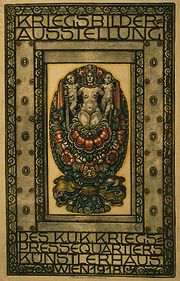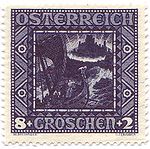
Wilhelm Dachauer
Encyclopedia

Austria
Austria , officially the Republic of Austria , is a landlocked country of roughly 8.4 million people in Central Europe. It is bordered by the Czech Republic and Germany to the north, Slovakia and Hungary to the east, Slovenia and Italy to the south, and Switzerland and Liechtenstein to the...
n painter. He studied at the Akademie der bildenden Künste in Vienna from 1899 to 1907 and was professor from 1928 to 1944 at the same academy.
Life
Wilhelm Dachauer was born on April 5, 1881 into a family of clockmakers. He was intended to continue his fathers business but after some struggle he was allowed to move to Vienna, where he had a time full of privations. He started an apprenticeshipApprenticeship
Apprenticeship is a system of training a new generation of practitioners of a skill. Apprentices or protégés build their careers from apprenticeships...
as decoration painter and in the nighttime he prepared for the Academy of Applied Arts. In 1899 the seventeen year old Wilhelm began his studies under the supervision of professor Griepenkerl
Christian Griepenkerl
Christian Griepenkerl was a German painter and professor at the Academy of Fine Arts Vienna.Griepenkerl was born to one of Oldenburg's leading families...
.
In 1913 he had his first arguably successful exhibition at the Secession
Vienna Secession
The Vienna Secession was formed in 1897 by a group of Austrian artists who had resigned from the Association of Austrian Artists, housed in the Vienna Künstlerhaus. This movement included painters, sculptors, and architects...
. He was appointed to an honored professorship of the Akademie der bildenden Künste (Academy of Applied Arts) in Vienna in 1928, a position that he occupied until 1944. Temporarily he was even rector of the institution. Among his students were Hildegard Joos, Maria Lassnig
Maria Lassnig
Maria Lassnig is an Austrian artist. Her paintings are an exploration of the body, a central theme which she calls "body awareness"....
, Adalbert Pilch
Adalbert Pilch
Adalbert Pilch was an Austrian painter and graphic artist.The works of Adalbert Pilch include paintings, drawings and illustrations...
, and Peppino Wieternik (1919-1979).
Wilhelm Dachauer died in Vienna on February 26, 1951.
Opus

Realism (arts)
Realism in the visual arts and literature refers to the general attempt to depict subjects "in accordance with secular, empirical rules", as they are considered to exist in third person objective reality, without embellishment or interpretation...
that was strongly dedicated to rural and regional arts. This style fitted well to the "official" taste of the Ständestaat and the NS regime
Nazism
Nazism, the common short form name of National Socialism was the ideology and practice of the Nazi Party and of Nazi Germany...
, so his opus became somewhat disreputable after 1945.

Postage stamp
A postage stamp is a small piece of paper that is purchased and displayed on an item of mail as evidence of payment of postage. Typically, stamps are made from special paper, with a national designation and denomination on the face, and a gum adhesive on the reverse side...
series than for his other paintings. Among his stamp designs are the well-known set of the Nibelungen motifs and the inventor set; other motifs are: Stille Nacht and Johann Strauß.
In 1926 he was awarded the Thomson medal for the most beautiful stamp in the world for the second stamp of the before mentioned Nibelungen set. The design of this stamp has the title "Gunters Drachenschiff auf dem Weg nach Island" (Gunter's Dragon Boat on the Way to Island). This stamp has a nominal value of 8+2 g (Groschen
Groschen
Groschen was the name for a coin used in various German-speaking states as well as some non-German-speaking countries of Central Europe , the Danubian principalities...
).
After the annexation
Annexation
Annexation is the de jure incorporation of some territory into another geo-political entity . Usually, it is implied that the territory and population being annexed is the smaller, more peripheral, and weaker of the two merging entities, barring physical size...
of Austria to the German Reich and the occupation of Poland he designed several other stamps of the so-called Generalgouvernement
General Government
The General Government was an area of Second Republic of Poland under Nazi German rule during World War II; designated as a separate region of the Third Reich between 1939–1945...
and a few of the German Reich.
He also made the designs for several Austrian stamps after World War II
World War II
World War II, or the Second World War , was a global conflict lasting from 1939 to 1945, involving most of the world's nations—including all of the great powers—eventually forming two opposing military alliances: the Allies and the Axis...
, among them the so-called Homecomer series.
Ten glass windows and one altarpiece of the Franziskaner hospital chapel in Ried 1928 are designs of Dachauer. More conserved works are the portraits of Julius Wagner-Jauregg
Julius Wagner-Jauregg
Julius Wagner-Jauregg was an Austrian physician, Nobel Laureate, and Nazi supporter.-Early life:...
and Viktor Kaplan
Viktor Kaplan
Viktor Kaplan was an Austrian engineer and the inventor of the Kaplan turbine.-Life:Kaplan was born in Mürzzuschlag, Austria into a railroad worker's family. He graduated from high school in Vienna in 1895, after which he attended the Technical University of Vienna, where he studied civil...
.
Nowadays a street - the Wilhelm-Dachauer Straße in Essling
Essling
Essling is part of Donaustadt, the 22nd district of Vienna.The area is known because of the Battle of Aspern-Essling, which was fought nearby on May 21 and May 22, 1809....
, the 22nd borough of Vienna - is named after this more or less famous painter.
External links
- http://www.archiv-verlag.at/inhalte/loseblatt/oberoearchiv1.html (in German)
- http://www.artnet.com/artist/659675/wilhelm-dachauer.html
Image: http://www.uni-klu.ac.at/kultdoku/kataloge/33/bilder/10_27.jpg

